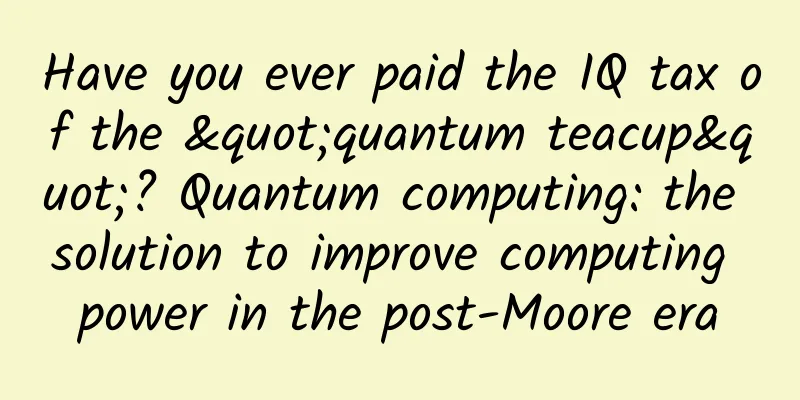Have you ever paid the IQ tax of the "quantum teacup"? Quantum computing: the solution to improve computing power in the post-Moore era

|
"Quantum" is already a hot research field. As a bystander, you may have used the joke "When in doubt, use quantum mechanics" or paid the IQ tax of "quantum teacup"... But what is quantum technology? Do you know? Focusing on the theme of quantum information technology, the team of Academician Pan Jianwei wrote this popular science article, which gave a relatively complete introduction and outlook on quantum information technology. Quantum computing is a new computing model based on quantum mechanics. It has powerful parallel computing capabilities that far exceed classical computing in principle. It provides solutions to large-scale computing problems required for artificial intelligence, cryptanalysis, weather forecasting, resource exploration, drug design, etc., and can reveal complex physical mechanisms such as quantum phase change, high-temperature superconductivity, and quantum Hall effect. Unlike traditional computers that use bits of 0 or 1 to store information, quantum computing uses quantum bits as the basic unit of information encoding and storage. Based on the superposition principle of quantum mechanics, a quantum bit can be in a coherent superposition of two states, 0 and 1, at the same time, that is, it can be used to represent the two numbers 0 and 1. By extension, n quantum bits can represent the superposition of 2n numbers, so that a quantum operation can in principle realize parallel operations on 2n superimposed numbers at the same time, which is equivalent to a classical computer performing 2n operations. Therefore, quantum computing provides a way to fundamentally realize parallel computing, and has the potential to greatly surpass the computing power of classical computers. Similar to classical computers, quantum computers can also use the framework of Turing machines, perform general quantum operations by performing programmable logical operations on quantum bits, thereby achieving a significant increase in computing power, or even exponential acceleration. A typical example is the fast prime factorization quantum algorithm (Shor's algorithm) proposed in 1994. The computational complexity of prime factorization is the basis for the security of the widely used RSA public key cryptographic system. For example, if a classical computer with a trillion operations per second is used to decompose a 300-bit large number, it will take more than 100,000 years; if a quantum computer with the same computing speed and executing Shor's algorithm is used, it will only take 1 second. Therefore, once quantum computers are successfully developed, they will have a huge impact on the classical information security system. Stages of development of quantum computing The computing power of quantum computers increases exponentially with the number of quantum bits, so the core task of quantum computing research is the coherent manipulation of multiple quantum bits. Based on the scale of coherently manipulated quantum bits, the international academic community generally recognizes that quantum computing has the following development stages: The first stage is to achieve "quantum computing superiority", that is, the computing power of quantum computers for specific problems exceeds that of classical supercomputers. To achieve this goal, coherent manipulation of about 50 quantum bits is required. Google in the United States took the lead in achieving "quantum computing superiority" in superconducting circuit systems in 2019. China achieved "quantum computing superiority" in optical quantum systems in 2020 and in superconducting circuit systems in 2021. At present, China is the only country in the world that has reached this milestone in two physical systems. The second stage is to realize a dedicated quantum simulator, that is, to coherently manipulate hundreds of quantum bits, which can be applied to specific problems such as combinatorial optimization, quantum chemistry, and machine learning, and guide material design, drug development, etc. It will take 5 to 10 years to reach this stage, which is the current main research task. The third stage is to realize a programmable universal quantum computer, that is, to coherently manipulate at least millions of quantum bits, which can play a huge role in classical password cracking, big data search, artificial intelligence, etc. Since quantum bits are easily affected by environmental noise and make errors, for large-scale quantum bit systems, it is an inevitable requirement to ensure the correct operation of the entire system through quantum error correction, which is also the main challenge faced for a period of time. Due to the technical difficulty, it is not clear when a universal quantum computer will be realized. The international academic community generally believes that it will take 15 years or even longer. At present, the world is conducting systematic research on various physical systems that are expected to achieve scalable quantum computing. China has completed the research layout of all important quantum computing systems, becoming one of the three countries (regions) with a complete layout, including the European Union and the United States. Superconducting quantum computing catches up At present, Google, IBM and the University of Science and Technology of China are the top three in the world in superconducting quantum computing research. In October 2019, after more than 10 years of continuous heavy investment in quantum computing, Google officially announced that it had experimentally proved "quantum computing superiority". They built a quantum processor containing 53 superconducting quantum bits, named "Sycamore". In the specific task of random circuit sampling, "Sycamore" showed computing power far exceeding that of supercomputers. In May 2021, the University of Science and Technology of China built the 62-bit superconducting quantum computing prototype "Zu Chongzhi", which had the largest number of quantum bits in the world at that time, and realized programmable two-dimensional quantum walks. On this basis, the 66-bit "Zu Chongzhi No. 2" was further realized. "Zu Chongzhi No. 2" has the programming ability to execute any quantum algorithm and realizes the rapid solution of quantum random circuit sampling. According to the currently disclosed optimal classical algorithm, "Zu Chongzhi No. 2" processes quantum random circuit sampling problems 10 million times faster than the fastest supercomputer currently available, and the computational complexity is 1 million times higher than that of Google's "Planeta". Quantum computing research in other systems Ions, silicon-based quantum dots and other physical systems also have the potential for multi-bit expansion and fault tolerance, and are also hot topics in international quantum computing research. my country started late in quantum computing research on ion systems and is currently in a catching-up state. Domestic leading research units include Tsinghua University, University of Science and Technology of China, and National University of Defense Technology, which have accumulated a large number of key technologies in the basic elements of quantum computing such as the preparation of ion traps, single-ion coherence retention time, high-precision quantum logic gates, and multi-bit quantum entanglement. my country is at the same level as major international research forces in the direction of quantum computing of silicon-based quantum dots. In addition, due to the superiority of topological quantum computing in fault tolerance, using topological systems to achieve universal quantum computing is an important long-term research goal internationally. At present, both China and foreign countries are working hard to achieve the "0 to 1" breakthrough of a single topological quantum bit. The future of quantum computing After achieving the stage goal of "quantum computing superiority", the future development of quantum computing will focus on two aspects: The first is to continue to improve quantum computing performance. In order to achieve fault-tolerant quantum computing, the first consideration is how to expand the scale of quantum computing systems with high precision. When implementing quantum bit expansion, the number and quality of bits are extremely important. Every link of the experiment (preparation, manipulation and measurement of quantum states) must maintain high precision and low noise. As the number of quantum bits increases, the errors caused by factors such as noise and crosstalk also increase. This poses a huge challenge to the design, processing and regulation of quantum systems, and still requires a lot of collaborative efforts from science and engineering. The second is to explore the application of quantum computing. It is expected that in the next five years, quantum computing will exceed thousands of bits. Although fault-tolerant general quantum computing cannot be achieved for the time being, scientists hope to explore the application of quantum computing in the fields of machine learning, quantum chemistry, etc. in the noisy quantum computing (NISQ) stage to form near-term applications. |
<<: Southerners vs Northerners, who is fatter? The truth is...
Recommend
Mercedes-Benz: Mercedes-Benz global sales in Q4 2023 were 514,000 units, with annual cumulative sales reaching 2,043,800 units
According to media reports, Mercedes-Benz recentl...
Is He Jiong’s joining Alibaba Music’s content layout inseparable from the celebrity effect?
On December 29, Gao Xiaosong announced on Weibo t...
The most amazing history of Song Dynasty
The most amazing history of Song Dynasty in histor...
Tourism promotion, how does Lanzhou Tourism Company conduct online promotion?
As people's living standards continue to impr...
Beware! 58% of global human infectious diseases are becoming more severe due to climate change…
The global disaster caused by the COVID-19 pandem...
This parrot's dopamine dressing style is really hard to learn!
The gateway to the eastern and western hemisphere...
How to innovate brand marketing methods?
As a highly forward-looking content in the field ...
Looking at the WeChat Open Class H5 that has been all over the circle of friends from an operational perspective, do you really know how to do a year-end inventory?
WeChat was officially released on January 21, 201...
Content Promotion|How to build private domain traffic?
As China's mobile Internet penetration accele...
If you see this kind of flower on a date, you must step on it to death immediately!
Source: Dr. Curious This article has been authori...
What are the parts of crayfish that you cannot eat? The shrimp thread, the shrimp roe, or...
In summer, crayfish becomes the "king of mid...
How can traffic be doubled relying solely on content? It's time to think about your KPIs!
The golden age of short videos Why do we say that...
OPPO R7 Plus review: The enlarged "heartthrob" is even more beautiful
OPPO R7, known as the "heartthrob", is ...
10 tips for KOL marketing!
As a person who has been working in the market fo...
Former App Store executive reveals seven truths about "Apple Recommendations"
"As long as my game is good enough, it will ...









